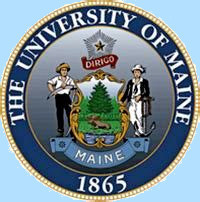
Yes, indeed, in the morning it was classes and, in the afternoon, construction. Founded in 1862, the University of Maine at Orono opened its doors for the first time on September 21, 1868. When the writers of the American Guide Series book,
Maine: a Guide 'Down East' visited the campus of the University of Maine at Orono, it still lacked many of the buildings and facilities one finds today, but, by the late 1930s, it was possessed of the majority of the historic buildings that remain. Too, significant portions of the original layout were taken from a design by landscape architect Frederick Law Olmsted. A second master plan, by Carl Rust Parker of the Olmsted Brothers firm, was adopted in 1932 and had been, for the most part, implemented by this time.
See the full excerpt dealing with the University of Maine at Orono, from
Maine: a Guide 'Down East', below.
Today the flagship campus of the University of Maine, Orono campus hosts over 11,000 students. The largest university in the state, it is the only institution in Maine classified as a research university. Originally known as the Maine College of Agriculture and the Mechanic Arts, today the university boasts 90 undergraduate programs within five Colleges: the College of Business, Public Policy and Health; the College of Education and Human Development; the College of Engineering; the College of Liberal Arts and Sciences and the College of Natural Sciences, Forestry and Agriculture.
In terms of facilities, the university also boasts
thirty-seven academic buildings, thirty administrative buildings, eighteen residence halls, eighteen specific laboratory facilities, fourteen Greek life houses, ten sports facilities, five museums, four dining facilities, two convenience stores, a student union, a cafe, a pub, an 87,000-square-foot state of the art recreation and fitness center, and a 200'x200' air supported athletic/recreational dome.
From Wiki
The buildings and grounds of the University of Maine (L) (open) stretch for three-quarters of a mile along the northeastern outskirts of the village. The 500-acre campus, with its well-kept lawns and shade trees, overlooks the Stillwater River. So well hidden by trees are the modern brick and stone college buildings, some of which have Georgian and Gothic features, that no single one dominates the campus. Fraternity chapter houses of no architectural style line College Road from the campus south to the village center.
The University of Maine is a part of the State's educational system.
Established originally as a State College of Agriculture and Mechanic
Arts under the provision of the Morrill Act, approved by President
Lincoln in 1862, the State of Maine accepted the conditions of the act the following year and in 1865 created a corporation to administer the affairs of the college. The institution opened September 21, 1868, with a class of 12 members and two teachers. Tuition was often paid in cordwood, or other local produce. By 1871, four curricula had been arranged agriculture, civil engineering, mechanical engineering, and elective which gradually developed into the present college of agriculture, technology, and arts and sciences. The name, University of Maine, was assumed in 1899.
The College of Agriculture, the outstanding unit of the University, comprises the various departments of agriculture and husbandry as well as bacteriology, geological chemistry, forestry, home economics and horticulture. Although a four-year course is required for the degree of bachelor of science in agriculture, the college offers a two-year course and special short courses in these subjects which have become unusually popular. Its courses in forestry have been widely recognized. The University maintains a forestry camp in Indian Township near Princeton. Throughout the year extension lectures are given; and an extension service analyzes soils, studies animal and crop diseases, and distributes scientific and practical information to farmers.
The Maine Agricultural Experiment Station was established as a division of the University by an act of the legislature of 1887 as a result of the Hatch Act. Its offices and principal laboratories, besides the one at Orono, are at Highmoor Farm in Monmouth, and Aroostook Farm at Presque Isle. The University also operates a
marine biological station at East Lamoine on the shore of Frenchman's
Bay.
The University buildings are best reached from the Administration
Building (campus guides and maps available). Parking space is always
available, and during the summer direction markers are posted along the drives.
The Carnegie Library, a two-story granite building with glass-enclosed central rotunda, houses the University library of 1 50,000 volumes and pamphlets, and also its art collection.
From Maine: a Guide 'Down East'